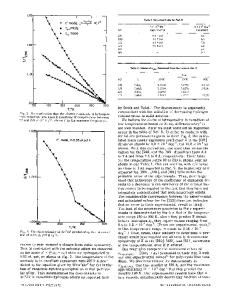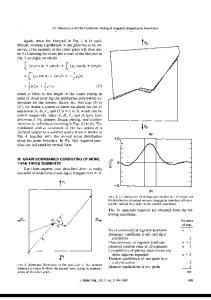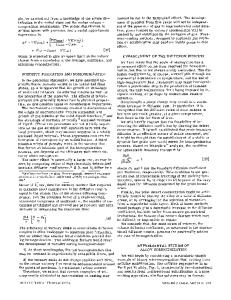Reexamination of grain-boundary sliding by diffusion
- PDF / 455,990 Bytes
- 5 Pages / 594 x 774 pts Page_size
- 96 Downloads / 444 Views
I.
INTRODUCTION
THEORETICAL investigation of the rate of sliding of two crystals over each other was widely performed in the early 1970's. With respect to the atomistic aspects of the problem; Ashby presented a model for the sliding of a symmetric tilt boundary and derived a relationship among the microscopic, intrinsic grain boundary sliding rate, and the applied stress.1 For a nonplanar boundary which has bumps or serrations on it, steady-state sliding is possible only when the incompatibility at the boundary is accommodated. This means that matter must be transported either by diffusion or by plastic flow. Although mechanisms in which the sliding arises from the glide and climb motion of dislocations have also been developed, 2'3'4 many experimental results for the case of sliding at low stresses and high temperatures have been explained consistently in terms of diffusion-controlled sliding. ~'6'7 In addition, Nabarro-Herdng creep 8'9 and Coble creep ~~ are related to the diffusion-controlled boundary sliding, u The mechanism of such boundary sliding has been discussed theoretically by Gifkins and Snowdon,t2'13 and Raj and Ashby. 11 Raj and Ashby u made a detailed calculation of the steadystate sliding rate and obtained solutions for the stress fields, diffusive fluxes, and rates of sliding. Although their analysis has generality, it is rather complicated since they described the shape of the grain boundary with a Fourier series. Thus, except for a simple sinusoidal shape of the grain boundary, numerical calculation is inevitable to evaluate the sliding rate. In this paper, we would like to present a simple alternative method to evaluate the steady-state sliding rate which involves neither a Fourier series nor knowledge of a local stress field. The basic concept behind the present approach is that the change (decrease) in the potential energy of an applied stress is identified as the driving force for the boundary sliding. The sliding rate for a boundary which contains second phase particles has been derived by Raj and Ashby, u and by Mori et al., 5 when accommodation process around the particles limits the sliding rate. Raj and Ashby treated the problem with an electrostatic analogy and Mori et al. used the result of the inclusion problem in continuum mechanics. SUSUMU ONAKA, Graduate Student, MASAHARU KATO, Associate Professor, and T. MORI, Professor, are with the Department of Materials Science and Engineering, Tokyo Institute of Technology, 4259 Nagatsuta, Midori-ku, Yokohama 227, Japan. Manuscript submitted September 12, 1985. METALLURGICALTRANSACTIONS A
As another application of the present analysis, we would also like to deal with this problem. As we will see later, the present approach can yield as accurate expressions as those obtained by the previous more involved analyses.
II.
BASIC CONCEPTS
Let us fhst clarify the basic physical concepts of the present analysis. Consider a Maxwell unit, as in Figure 1, made of a spring and a dashpot attached together in series. For the case of the diffusion-con
Data Loading...











